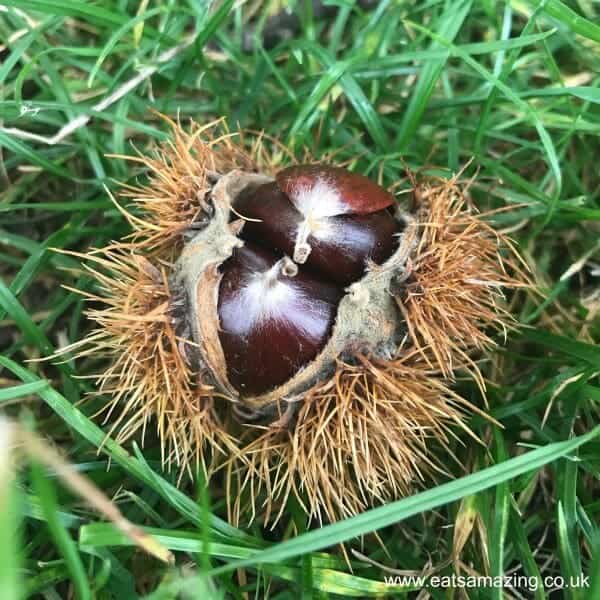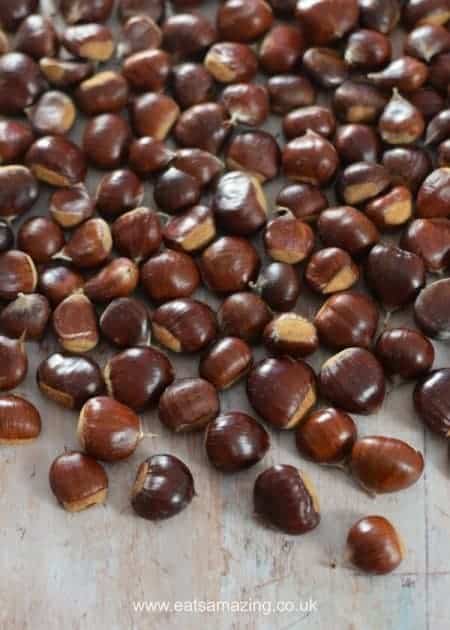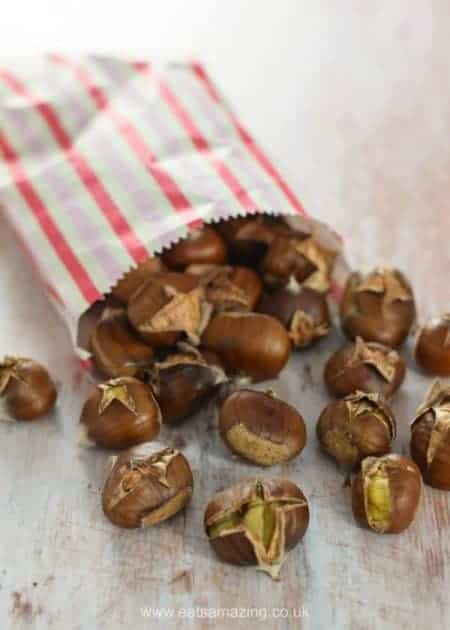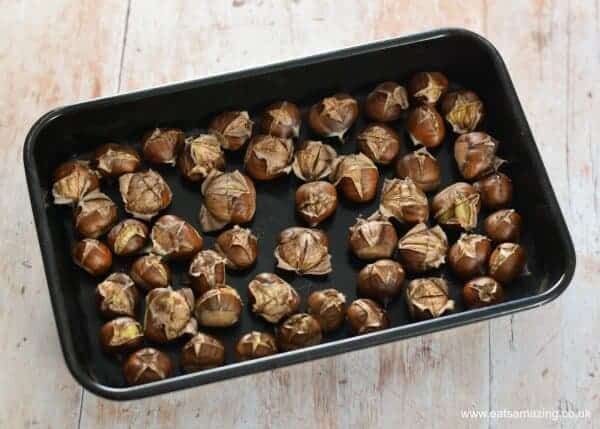Today I'm sharing everything I know about picking and roasting chestnuts. Foraging for food is such a wonderful activity to do with your children. It gets them outside in the fresh air, keeps them active (not always so easy when the autumn weather turns chilly) and really connects them with nature and with where our food comes from. Plus, its free - you can't beat free food, straight from nature!

In late summer and early autumn we love picking blackberries, but as autumn really kicks in we start our hunt for chestnuts. We've been lucky to live within easy walking distance of chestnut trees in the last two houses that we've lived in, so picking and roasting fresh chestnuts has become an essential part of our autumn every year.
If you're not sure how to identify sweet chestnut trees, this time of year is the perfect time to find them - look for trees with similar (but longer) leaves to the horse chestnut tree but with a carpet of prickly cases around them, they're often found in both parks and growing in the streets.

Are chestnuts the same as conkers?
Not to be confused with horse chestnuts (conkers), which are mildly poisonous and definitely not edible for humans, sweet chestnuts are completely different. You can identify edible sweet chestnuts by their extremely prickly cases (they look like hairy little monsters or sea urchins!) and the distinctive tear-drop shape of the nut. There are usually 2 or 3 chestnuts to a case.
When can you find and harvest chestnuts?
Chestnuts are normally ready to harvest from mid to late October here in the UK. From personal experience, we usually start finding sweet chestnuts once the horse chestnuts have finished dropping their conkers, so we collect conkers for playing and crafting with first, then sweet chestnuts for eating later in the autumn. A ripe chestnut should be harvested from the floor around the tree rather than from the tree itself as they aren't ripe until they drop. Look for shiny brown chestnuts that feel firm, the bigger the better. If the lower part of the chestnut is white or pale yellow, it's not ripe yet so leave it for the squirrels, as I tell my boys!

The freshest chestnuts can be found still in their prickly cases. If you haven't come out armed with thick gardening gloves, try pulling them apart by standing on the case, one foot on each side until it splits and the chestnuts pop out. Be careful of all the prickly cases, they can hurt little (and big!) fingers.

How long can you store chestnuts?
Once you've harvested your sweet chestnuts, you can store them uncooked in the fridge for a couple of weeks, preferably in a bowl or tub. Don't store them in a sealed plastic bag as they'll go mouldy. We've found from personal experience that the quicker you roast them the better though, as they start drying out over time.
Are chestnuts good for you?
Chestnuts are lower in calories and fat than most other nuts. They're actually classed as starchy food, like sweet potato or sweet corn. They're full of minerals, nutrients and vitamins, particularly vitamin C, they're an excellent source of fibre and are rich in folates too. They're also naturally gluten free. Delicious AND good for you - win win!

How to roast chestnuts
We always roast our chestnuts, it's easy to do and the chestnuts taste sweet and delicious cooked this way! Pick the biggest, shiniest chestnuts that are firm to touch for roasting.
Start by pre-heating your oven to 200°C (Gas mark 6/400°F).
With the tip of a sharp knife, cut a cross into the rounded side of each chestnut.

Place the chestnuts, cross side up, in a small roasting tin or baking tray.

Once the oven is ready, pop the tray of chestnuts inside and roast for around 30 minutes until the skins have burst open and you can see the pale flesh inside.

Remove from the oven and leave until just cool enough to handle.
Working quickly, peel the outer skin and pale inner skin from the chestnut and discard, eating just the sweet flesh inside.
Enjoy!

Notes: The chestnuts are easiest to peel when warm, so do serve straight away.
I like to serve ours in paper bags with a bowl for the skins - everyone has a go at peeling their own, it's all part of the fun!
Do you forage for food with your children?
Grace
How to Roast Chestnuts
Ingredients
- 500 g sweet chestnuts
Instructions
- Start by pre-heating your oven to 200°C (Gas mark 6/400°F).
- Pick the biggest, shiniest chestnuts that are firm to touch for roasting. With the tip of a sharp knife, cut a cross into the rounded side of each chestnut.
- Place the chestnuts, cross side up, in a small roasting tin or baking tray.
- Once the oven is ready, pop the tray of chestnuts inside and roast for around 30 minutes until the skins have burst open and you can see the pale flesh inside.
- Remove from the oven and leave to cool until just cool enough to handle.
- Working quickly, peel the outer skin and pale inner skin from the chestnut and discard, eating just the sweet flesh inside.
Notes
I hope you found this post useful, please pin it if you did! For more posts about foraging and growing food with children, check out the Growing Food with Kids section here on the Eats Amazing blog or pop over and follow my Gardening With Kids Pinterest board for more inspiration from all around the web.




Sharon says
I remember eating chestnut as a kid. Not roasted. But I can't recall how to tell if they are ready to eat. I remember them bring super good. I picked up some at my Moms graveside. But one I ate was super nasty. Was it not ripe? Or was it Horse chestnut? I don't know.
Grace Hall says
Hi Sharon, horse chestnuts grow in a slightly bigger, less prickly shell and tend to be larger and rounder in shape. You usually only have one horse chestnut to a shell too, instead of 2. I wouldn't recommend eating them - they are toxic to humans! If it was a sweet chestnut, it may have gone off. At their best, roasted chestnuts should have pale golden flesh, but they get darker the older they get and taste quite unpleasant when spoiled. I also wouldn't eat them raw - chestnuts should be cooked or roasted before eating. Hope that helps!
Jez Jones says
Brilliant detail, just a quick question once cooked can you store ? Best way to store? How long could they be stored for ?
Jez
Grace Hall says
Thank you! Great question - once cooked, you can cool them and store them in the fridge (still in their shells) for a couple of days. I hope that helps!
Tina Wildcat says
Cherokee Indians have been eating chestnuts for hundreds of years here in America. They can be frozen for 1 year -4 different ways - raw in the shell , roasted and peeled, raw and peeled , or boiled then peeled.
Grace Hall says
Thank you for your comment, that's really interesting and great to know that they can be frozen too!